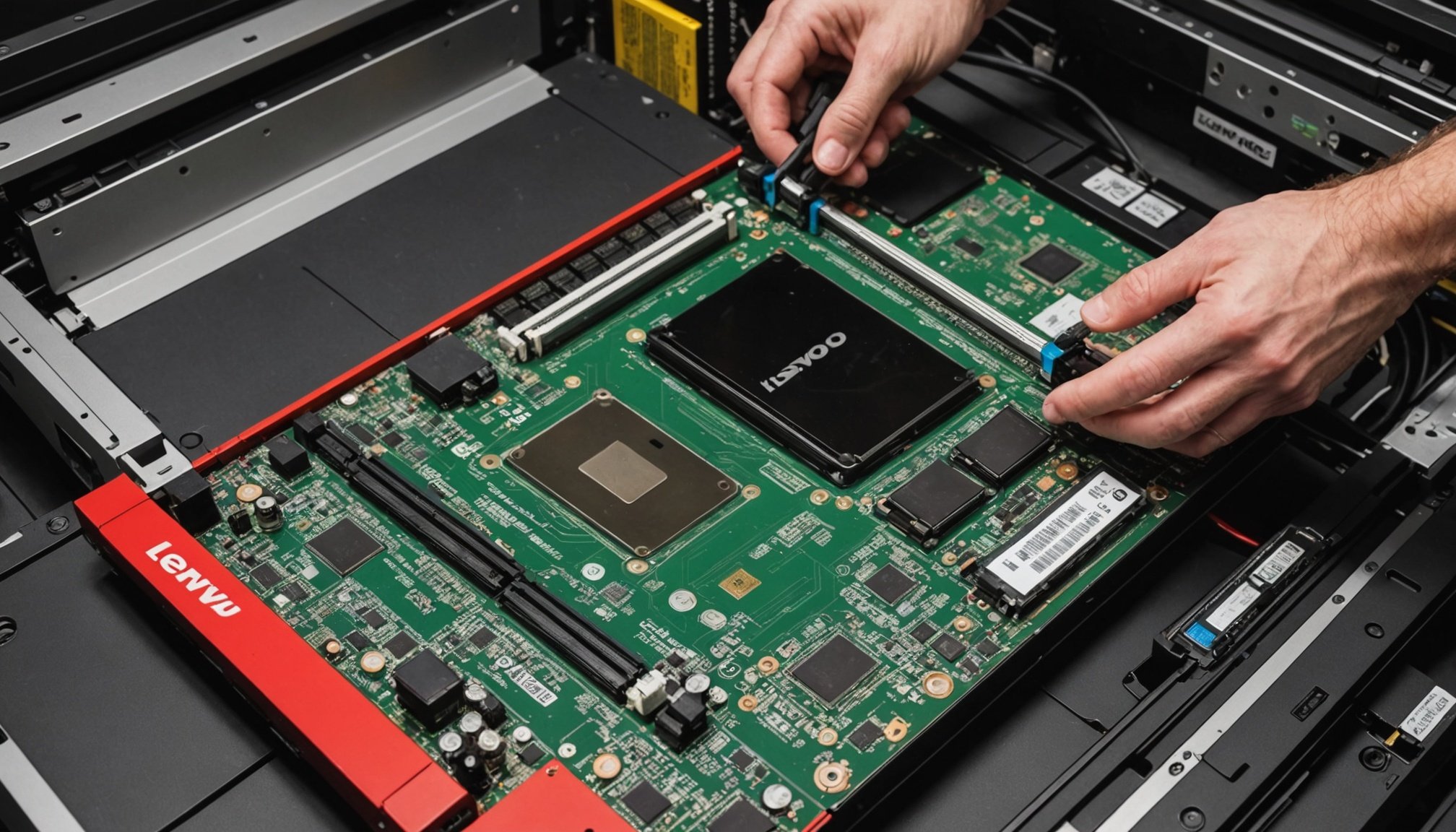Understanding the Importance of RAM Upgrade
RAM plays a crucial role in determining the overall performance of a computer system. For users of workstations, such as the Lenovo ThinkStation P620, it is imperative to understand how a RAM upgrade can significantly enhance system efficiency.
Upgrading RAM leads to better multitasking, faster processing speeds, and improved software performance. Workstations often run resource-intensive programs that require substantial memory allocation, making a RAM upgrade a necessary step for optimal productivity. With more RAM installed, users can run multiple applications simultaneously without experiencing slowdowns, thus maximising their workflow efficiency.
Have you seen this : Comprehensive Guide to Setting Up a High-Speed and Secure VPN on Your ASUS RT-AX86U Router
Specific to the Lenovo ThinkStation P620, a RAM performance upgrade can unlock the full potential of this high-end workstation, allowing users to handle complex tasks effortlessly. The P620 is designed to be compatible with multiple RAM configurations, enabling users to tailor their setup according to their specific needs. An increase in RAM capacity will not only elevate system responsiveness but also ensure smoother execution of high-demand applications, such as 3D rendering and data analysis tasks.
In essence, for workstation users, particularly those opting for the Lenovo ThinkStation P620, a RAM upgrade is a strategic move that yields tangible performance benefits.
In the same genre : Comprehensive Handbook for Building Your Raspberry Pi Home Security System with MotionEye: Essential Configurations for Optimal Performance
Compatibility Specifications for RAM
Understanding compatible RAM specifications is essential to unlock the full potential of your Lenovo ThinkStation P620. The system primarily supports DDR4 RAM, known for its efficiency and speed, a significant upgrade over older RAM types. DDR4 offers improved bandwidth and lower power consumption, making it suitable for the demanding tasks typical in professional workstations.
Types of Compatible RAM
The Lenovo P620 supports various RAM types but focuses on DDR4 due to its performance benefits. Users should ensure their RAM modules meet the necessary standards to avoid compatibility issues.
Capacity Options
When considering capacity options, the needs of your applications should guide your decision. For optimal performance, it is recommended that users opt for higher RAM capacities, especially when engaging in intensive tasks such as 3D rendering or complex data analysis. The more RAM available, the better the system can handle multiple processes simultaneously.
Speed Requirements
Matching the speed of new RAM modules with existing ones is crucial. DDR4 RAM requirements emphasize synchronising speeds to prevent bottlenecking issues. It’s vital to verify RAM speed to maintain system stability and maximise productivity, ensuring that all modules operate in harmony with one another.
Tools and Safety Precautions
When performing a RAM upgrade, using the appropriate installation tools is essential to ensure a smooth and successful process. For the Lenovo ThinkStation P620, you will need a small Philips screwdriver, anti-static wristband, and a soft cloth to clean internal components. These items help you safely access and handle your workstation’s internals.
A crucial safety measure involves taking precautions against static discharge. Before handling RAM, ensure you wear an anti-static wristband to prevent static electricity from damaging sensitive components. Additionally, grounding yourself by touching a metal part of your workstation will further mitigate this risk.
Safe handling practices are vital during RAM installation. Always handle RAM modules by the edges, avoiding contact with gold connectors to reduce the potential for damage. Ensuring a clean, clutter-free work area minimises accidental damage to your workstation.
By adhering to these safety precautions and utilising the listed tools, the risk of damage during RAM installation on a Lenovo ThinkStation P620 is significantly reduced. This ensures a smoother upgrade process, allowing users to confidently enhance their system performance with memory upgrade benefits.
Updating BIOS Settings
After upgrading RAM, updating the BIOS settings on your Lenovo ThinkStation P620 is crucial to ensure optimal system performance. BIOS, or Basic Input/Output System, functions as the communication bridge between your machine’s hardware and software, including new RAM modules.
When to Update BIOS
Update your BIOS settings for RAM installation whenever you add or change RAM modules. This step enables your computer to recognise the added memory, applying necessary BIOS configuration adjustments. Proper recognition allows the system to leverage the added memory upgrade benefits.
Steps to Access and Configure BIOS
To access and configure BIOS settings on your ThinkStation P620, reboot your system and press the designated key (often “F2” or “Delete”) during startup. Once inside the BIOS menu, verify that the system correctly reflects the installed RAM capacity. Navigate through the settings to ensure they match your new memory specifications, such as speed and configuration.
Troubleshooting Common BIOS Issues
If your updated memory does not function correctly or is not recognised, several troubleshooting strategies can resolve this. Confirm the RAM is properly seated in its slots, and verify compatibility with your BIOS version. Consulting Lenovo’s official BIOS update resources can assist in identifying and correcting any persistent issues, ensuring smooth system functionality.
Step-by-Step Installation Guide
When embarking on a RAM installation process, following careful procedures ensures a successful upgrade.
Preparing the Workstation
Before installing RAM in your Lenovo ThinkStation P620, ensure the device is powered down and unplugged to prevent electrical hazards. This crucial step in the RAM installation process protects you and the workstation from potential damage.
Opening the Case
With the workstation turned off, it’s time to access its internal components. Use an appropriate screwdriver to remove screws and gently open the ThinkStation P620 case. Handle the panel with care to avoid damaging internal parts as you prepare for the RAM installation process.
Inserting the RAM Modules
You are now ready to insert new RAM modules. Begin by locating the RAM slots, taking note of any clips that secure existing modules in place. When **installing RAM, align the notch on the module with the slot groove, and press down firmly until it clicks into place. Ensure each module is securely installed to guarantee optimal connectivity and performance.
By diligently following this step-by-step installation guide, you ensure that your Lenovo ThinkStation P620 benefits maximally from the new RAM, enhancing overall system efficiency and responsiveness.
Verifying Successful Installation
Completing a RAM installation successfully in your Lenovo ThinkStation P620 is just the beginning. It is essential to ensure the new modules are functioning correctly.
Using System Information Tools
To verify your RAM installation, employ system information tools like Task Manager for Windows. This tool displays the RAM specifications, confirming whether your system recognises the additional memory. Ensure the total memory capacity matches what you installed.
Run Performance Tests
Assess system performance by running benchmark tests. Tools such as PCMark provide comprehensive performance evaluations. They gauge whether the RAM upgrade delivers the expected benefits, such as improved processing speed and multitasking ability, resulting in an enhanced workstation experience.
Troubleshooting RAM Issues
If the upgraded RAM is not recognised, troubleshooting is crucial. Start by reseating each module and checking for compatibility with the Lenovo P620 specifications. Ensure that all modules are securely placed in the slots. Verify that no debris obstructs connections, which could impede recognition. If issues persist, consulting Lenovo’s support or community forums can offer additional insights to maximise RAM performance.
Additional Resources and Support
For users seeking assistance with their RAM upgrade on the Lenovo ThinkStation P620, a variety of resources are available. Lenovo support provides comprehensive guides and technical documentation to facilitate the BIOS update process, addressing any complexities related to the hardware. Access to official resources ensures dependable solutions tailored for Lenovo products.
Online Forums and Communities
Online forums and communities are invaluable for discussing upgrade experiences and troubleshooting hurdles. Communities such as Lenovo’s own forums offer input from fellow P620 users, providing real-world insights and solutions not found in manuals. Engaging in these discussions can help address issues swiftly.
Manufacturer Documentation
Referring to manufacturer documentation assists in understanding the detailed setup and configurations available for the ThinkStation P620. The documentation outlines the compatible RAM specifications, installation processes, and troubleshooting steps, ensuring users have a reliable reference point during upgrades.
Staying informed through these reliable resources empowers users to navigate the challenges of RAM installation confidently. Leveraging expert advice and community feedback streamlines the upgrade process, enhancing the overall performance of the Lenovo ThinkStation P620.











